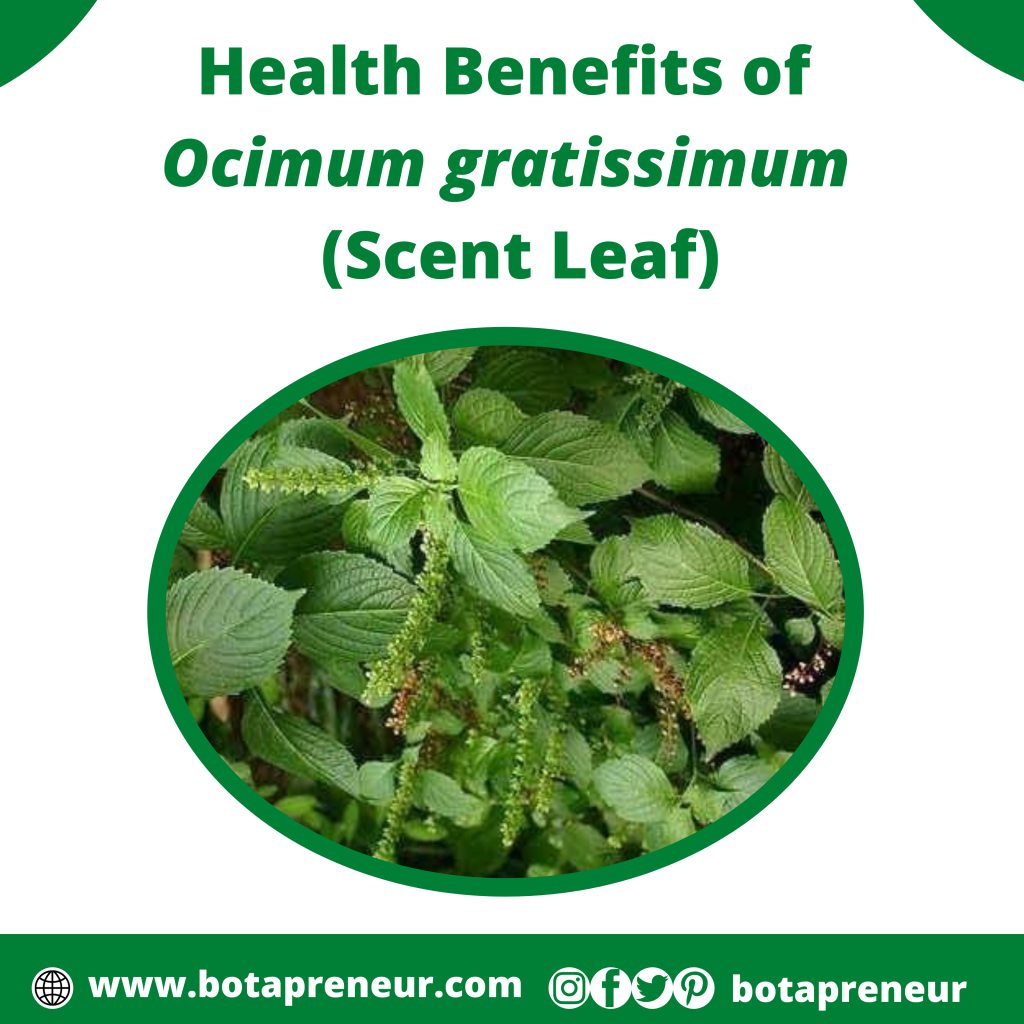Ocimum gratissimum popularly known as scent leaf, clove basil or African basil belongs to the family of Lamiaceae.
Ocimum gratissimum (Scent leaf) is very common in Nigeria among different tribes. Among the Yoruba, it is known as Efirin. It is known as Ahuju or Nchuanwu among the Igbo and as Ganyen Kamsh or ‘Daidoya’ among the Hausa. The Edo people call it Aramogbo while Ibibios call it Ntonng and some parts of Ijaw call it Ekeni.
It is known as alfavaca brave in Brazil, ajeka in Indian, African tea bush in Jamaica, ruku-ruku hitam in Malaysia, and canela in Cuba.
The Scent leaf is an aromatic herb and it contain several bioactive chemical substituents which include tannins, phenols, calcium, phosphorus, iron, vitamin A, eugenol, anetol, boron, stigmasterol, etc. All these chemical substituents are essential for human health.
Scent leaf serves majorly as condiment in human food.
In Nigeria, it is used as a local ingredient for cooking porridge , jollof rice, Ukwa and soups like Ogbono & Egusi. It is also widely used as condiment and for culinary purpose in the North east of Brazil.
Aside it’s use in food, it is also widely known for its therapeutic properties and medicinal uses across several countries.
The following are the uses of scent leaf got from researches and surveys:
1) Scent leaf was discovered to have been widely used in the treatment of epilepsy, high fever and diarrhoea in Nigeria. The decoction (boiling) of the leaves are also used to treat mental illness.
2) Scent leaf is also used by the Ibos of Southeastern Nigeria in the management of the baby’s cord, to prevent the wound from infection.
3) The flowers and the leaves of this plant are also rich in essential oils which can be used for aromatherapy massage. The oil can also be used in the manufacture of soaps, perfumes and ointments.
4) Previous studies have also reported that scent leaf has anesthesia, anti-stress, antidiarrheal, anthelminthic and antiinflammatory.
5) In Brazil, the decoction of the roots of the plant is used as a sedative for children.
6) In Kenyan and sub Saharan African region, the leaves are rubbed between the palms and sniffed as treatment for blocked nostrils.
7) Scent leaf is also used for treating abdominal pains, sore eyes, ear infections, coughs convulsions, and tooth ache.
8) Scent leaf is used in the regulation of menstruation. Also, when having menstrual cramps, one can brew it into tea to help with the pain.
9) In India, the whole plant is being used in
the treatment of influenza, as diaphoretic (generating sweat) and antipyretic (reduction of fever).
10) It is also used for skincare and helps to fight skin conditions like ringworm. Here, the leaves are mashed into a paste and apply on the skin.
11) Scent leaf is rich in vitamin A, which helps to promote good eyesight and also help to prevent xerophthalmia (A condition that occur due to deficiency of vitamin A whereby making the conjunctiva and cornea become dry).
12) The dried scent leaf is a powerful mosquito repellent.
13) Scent leaf aids digestion and prevents bloating.
14) Scent leaf is rich in calcium and magnesium which help to reduce bad cholesterol and increases blood circulation thereby helping to improve the function of the heart.
15) Scent leaf is a good source of arginine, an amino acid that helps in sperm vitality. It also contains compounds such as epigenin and eugenol which can stimulate erection.
Also, anetol and boron found in the leaves are capable of producing estrogen in women.
Research shows that a lot of benefits can be derived from just the consumption of scent leaves. Thereby, it is advisable to include scent leaf in our diet in considerable amounts.
It can either be used fresh or dried.
It can also be brewed as tea or juiced.
Also, it is very important to know that there is difference between scent and mint leaf, even though they look alike. One easily distinguishable difference is that mint leaf has a mild peppermint scent with a cool aftertaste.


What a nice write up. Keep it up ma